|
Rowe Pottery Works Historical Products for 2009
View Rowe History & Information Page |
To Order - Call Toll Free 866-884-3299 or 610-695-8151 - 10
to 5 Eastern Time Tue to Sat or
order by fax or 
After Hours Please leave a message, your name and a phone
number and time when we can call you back |
|
See Our Selection of Plate Hangers & Racks
- Includes Plate & Bowl Stands |
|
This Page Provide for Historical Information Only |
|
Because all of Rowe Pottery
products are handmade, you will not find the consistency of
machine made, production-line products. The size and shape of a
piece will vary and the individual decorator who creates your
piece will influence the pattern. Throwing ridges created by the
potter's hand as it turns on the wheel, brown flashings created
in the kiln where two pots "kiss" each other all add to the
character and uniqueness of your particular piece. These are
inherent traits of salt glaze stoneware and make each piece a
joy for you and generations to come.
Early Americans cherished
their stoneware for its durability in oven and hearth. Crocks,
jars and jugs had to withstand daily use and perform equally
well in extreme hot and cold temperatures. Today we enjoy
authentic salt glaze for the same reasons. It's 100% food safe
and use it in the oven, microwave and is dishwasher safe.
Rowe Pottery is handmade
with pride just like it was 150 years ago. |
|
Return to Rowe Pottery Index Page |
|
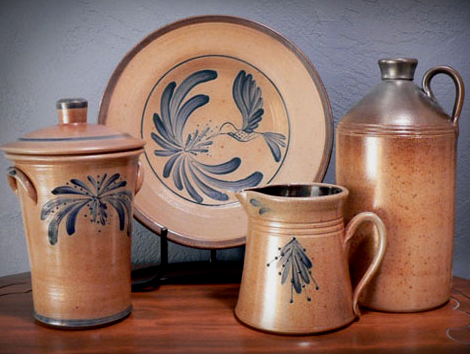
Historical 2009
Sorry - All Product Sold
Out |
|
Colorization varies greatly due to the Salt Glaze style of firing the pottery
- Colors from pale grey blue to dark brown are normal - we can not speculate on
what color you will receive - each is a limited edition - all will have brown
and blue spots |
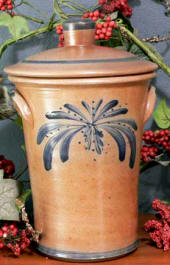
Wide Mouth Pickling Jar
Wide mouth jars are
one of the most straight-forward pottery forms, but continue to have a
utilitarian purpose in today’s world. Their most common purpose was for food
storage, but the wide mouth jar became popular as the perfect container for the
pro- cessing of pickled foods such as sauerkraut and cucumber pickles. In this
form the mouth opening is slightly larger than the base complimented by two lug
handles to assist in the lifting of the filled jar. The shape and mouth of this
jar are characteristic of the JM Wilson Jar of 1860 from Texas. The domed
hanging jar lid was particularly useful for pickling foods as it would rest
inside the mouth of the jar to keep the contents submerged in the pickling
solution. The lids of these jars were never tight and did not completely seal.
8.75"W x 6.75"H
Sorry - Sold |
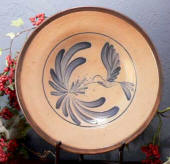
Large Platter
All tableware
including platters tended to be very rare pieces of historic pottery. Large
platters were difficult for potters to make as they were very heavy when wheel
turned and had a tendency to warp during firing. Tableware became more common
when larger industrialized pottery shops began to form in the 1900’s. Our 2009
Historical Platter is a hand pressed piece with a slightly thicker rim to
eliminate the common warping problem. This piece is a nice addition to this
years classic forms as it was less prevalent in the times. Our platter was also
designed with a dual purpose and can be hung on a wall, or displayed in a stand
to suit the taste of any homeowner
13" wide
Sorry - Sold |
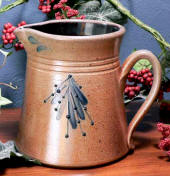
Pitcher
Pitchers are unique
historic pottery pieces as they are considered tableware, and tableware was not
commonly produced by potters. Our 2009 Historic Pitcher is generally referred to
as a cylindrical pitcher. A straight sided cylinder with established traditional
pitcher characteristics, a pulled pour spout with a handle affixed to the body
on the opposite side portray the pitcher chosen for this years collection. The
handle is a quintessential strap handle. Strap handles are formed by pulling the
clay to the desired design, then cutting and attaching it to the pitcher. Most
historic stoneware pitchers were decorated in cobalt blue and gray tones. Our
pitcher is characteristic of a pitcher made by Meyer Pottery in Texas during the
early 1900’s
6.25"h x 5.5"w
Sorry - Sold |
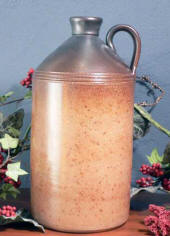
Jug
Jugs are probably the
most common form of stoneware manufactured throughout history. The jug was
designed as a liquid storage vessel and has a relatively small mouth which is
commonly designed for a cork type closure. Our straight sided jug would have
typically been used to store water, mineral water, hard liquor, wines, vinegars
or oils. Jugs began to transition to straight sides and defined shoulders in the
early 1900’s. The transition to this shape began when there was a transition
from small family owned pottery shops to large industrialized shops. Shapes
changed as the economics of production became more important
13"h x 5.5"w
Sorry - Sold |
|
Return to Rowe
Pottery Index Page
|
To Order - Call Toll Free 866-884-3299 or 610-695-8151 - 10
to 5 Eastern Time Tue to Sat or
order by fax or 
After Hours Please leave a message, your name and a phone
number and time when we can call you back |
|
See Our Selection of Plate Hangers & Racks
- Includes Plate & Bowl Stands |
|
Home -
Security Policy -
Privacy -
Purchase Policies -
Shipping -
Shop Our Store
|
|
Copyrighted © ® & TM: 2002-2025 - All rights reserved - Our American Heritage Web Shop, Inc.
All Images & content property of Our American Heritage. Inc. with
permission of
artists and manufacturers - NO
Reproduction by any means without express written authorization
|

